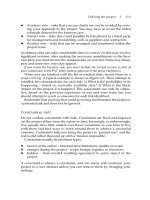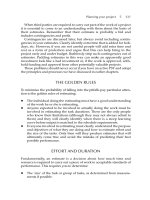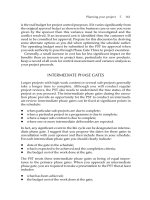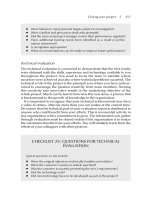Management a practical introduction 3rd kinicky chapter 15
Bạn đang xem bản rút gọn của tài liệu. Xem và tải ngay bản đầy đủ của tài liệu tại đây (271.77 KB, 33 trang )
Management
A Practical Introduction
Third Edition
Angelo Kinicki &
Brian K. Williams
Kinicki/Williams, Management: A Practical Introduction 3e ©2008, McGraw-Hill/Irwin
Chapter 15: Interpersonal &
Organizational Communication
Mastering the Exchange of
Information
The Communication Process
Barriers to Communication
How Managers Fit into the Process
Communication in the Information Age
Improving Communication Effectiveness
Kinicki/Williams, Management: A Practical Introduction 3e ©2008, McGraw-Hill/Irwin
15.1 The Communication Process:
What It Is, How It Works
WHY DO WE NEED TO UNDERSTAND THE
COMMUNICATION PROCESS?
Communication is the transfer of information and
understanding from one person to another
Good communication skills, both written and oral,
are essential to success
One study found that managers spend over 80
percent of their day communicating
Kinicki/Williams, Management: A Practical Introduction 3e ©2008, McGraw-Hill/Irwin
15.1 The Communication Process:
What It Is, How It Works
Communication is a process
The sender is the person wanting to share information,
called a message, and the receiver is the person for whom the
message is intended
Messages have to be encoded (translated into
understandable symbols or language)
Then, messages have to be decoded (interpreted and made
sense of)
The pathway by which a message travels is the medium
Feedback is the receiver’s reaction to the sender’s message
Any disturbance that interferes with the transmission of a
message is noise
Kinicki/Williams, Management: A Practical Introduction 3e ©2008, McGraw-Hill/Irwin
The Communication Process
Basic Model
McGraw-Hill/Irwin
Kinicki/Williams, Management: A Practical Introduction
3e ©2008,
McGraw-Hill/Irwin
© 2006
The McGraw-Hill
Companies, Inc. All rights rese
15.1 The Communication Process:
What It Is, How It Works
Figure 15.1: The Communication Process
Kinicki/Williams, Management: A Practical Introduction 3e ©2008, McGraw-Hill/Irwin
The Communication Process
Expanded Model
McGraw-Hill/Irwin
Kinicki/Williams, Management: A Practical Introduction
3e ©2008,
McGraw-Hill/Irwin
© 2006
The McGraw-Hill
Companies, Inc. All rights rese
The Communication Process
What
assignment do
you mean?
Did you finish
your
assignment?
Noise!
Noise!
Sender
McGraw-Hill/Irwin
Receiver
Kinicki/Williams, Management: A Practical Introduction
3e ©2008,
McGraw-Hill/Irwin
© 2006
The McGraw-Hill
Companies, Inc. All rights rese
15.1 The Communication Process:
What It Is, How It Works
HOW DO MANAGERS KNOW WHICH TYPE OF
COMMUNICATION TOOL TO USE?
Managers need to know how to use the right type of
communication tool for a given situation
How well a particular medium conveys information and
promotes learning is referred to as media richness
Media are positioned along a continuum ranging from high
media richness (face-to-face communication) to low media
richness (impersonal written media like newsletters)
In nonroutine situations, a rich medium works best
In routine situations, a lean medium works better
Kinicki/Williams, Management: A Practical Introduction 3e ©2008, McGraw-Hill/Irwin
The Selecting the Right Media
High Media Richness
(Best for nonroutine,
ambiguous situations)
Face-to-face
presence
McGraw-Hill/Irwin
Videoconferencing
Low Media Richness
(Best for routine, clear
situations)
Telephone
Personal written
media (e-mail,
memos, letters)
Impersonal
written media
(newsletters,
fliers, general
reports)
Kinicki/Williams, Management: A Practical Introduction
3e ©2008,
McGraw-Hill/Irwin
© 2006
The McGraw-Hill
Companies, Inc. All rights rese
Chapter 15: Interpersonal &
Organizational Communication
CLASSROOM PERFORMANCE SYSTEM
The pathway by which a message travels is called
A) encoding
B) decoding
C) the medium
D) feedback
Kinicki/Williams, Management: A Practical Introduction 3e ©2008, McGraw-Hill/Irwin
15.2 Barriers To Communication
WHAT ARE THE BARRIERS TO
COMMUNICATION?
Communication barriers are anything that
interferes with accurate communication between two
people
There are three types of barriers:
1. Physical barriers include things like time-zone
differences, office walls, and crashed computers
Kinicki/Williams, Management: A Practical Introduction 3e ©2008, McGraw-Hill/Irwin
15.2 Barriers To Communication
2. Semantic barriers occur when words can be
interpreted in different ways
Does “right away” mean today, tomorrow, in the
next hour?
The problem is intensified when jargon
(terminology specific to a particular profession or
group) is used
3. There are nine personal barriers that contribute to
miscommunication:
Kinicki/Williams, Management: A Practical Introduction 3e ©2008, McGraw-Hill/Irwin
15.2 Barriers To Communication
-variable skills in communicating effectively
Some people are naturally better communicators
than others
-variations in how information is processed &
interpreted
People use different frames of reference and
experiences to interpret information
-variations in trustworthiness & credibility
Communication is often flawed when there is a lack
of trust between the sender and receiver
Kinicki/Williams, Management: A Practical Introduction 3e ©2008, McGraw-Hill/Irwin
15.2 Barriers To Communication
-oversized egos
Egos influence how we treat each other and how
receptive we are to be influenced by others
-faulty listening skills
Sometimes, people simply fail to listen properly
-tendency to judge others’ messages
People judge others’ statements from their own
point of view
-inability to listen with understanding
It can be hard to put yourself in someone’s else’s
shoes and really listen
Kinicki/Williams, Management: A Practical Introduction 3e ©2008, McGraw-Hill/Irwin
15.2 Barriers To Communication
-stereotypes & prejudices
Stereotypes consist of oversimplified beliefs about
a certain group of people and can influence
communication
-nonverbal communication
Gestures and facial expressions are an important
part of communication
Kinicki/Williams, Management: A Practical Introduction 3e ©2008, McGraw-Hill/Irwin
15.2 Barriers To Communication
WHAT IS NONVERBAL COMMUNICATION?
Messages sent outside of the written or spoken word is
nonverbal communication
Nonverbal communication can be expressed through:
1. Interpersonal space (how close or far away one should be
when communicating) is a source of misunderstandings
Some cultures stand much closer than others
2. Interpretations of facial expressions like smiling can differ
across cultures
Kinicki/Williams, Management: A Practical Introduction 3e ©2008, McGraw-Hill/Irwin
15.2 Barriers To Communication
3. Eye contact signals the beginning and end of
conversations, expresses emotions, monitors feedback, and
can express the type of relationship between the people
communicating
4. Body movements and gestures are culture specific, so
interpreting them can be difficult
5. Norms for touching vary significantly by country
6. Setting
The setting in which the communication takes place
influences how it is received
7. Time
Keeping people waiting, not providing adequate time for
tasks, and so on are all ways that time becomes a form of
nonverbal communication
Kinicki/Williams, Management: A Practical Introduction 3e ©2008, McGraw-Hill/Irwin
15.2 Barriers To Communication
ARE THERE DIFFERENCES IN HOW MEN &
WOMEN COMMUNICATE?
There are a number of general differences in how
men and women communicate
Men tend to be more direct and blunt, women have
a softer approach, for example
Similarly, men tend to be stingy with praise while
women hand out lots of compliments
Kinicki/Williams, Management: A Practical Introduction 3e ©2008, McGraw-Hill/Irwin
15.3 How Managers Ft Into The
Communications Process
HOW DO MANAGERS USE THE DIFFERENT
CHANNELS OF COMMUNICATION?
There are both formal and informal channels of
communication
Formal communication channels follow the chain of
command and are recognized as official
There are three types of formal communications:
vertical, horizontal, and external
Kinicki/Williams, Management: A Practical Introduction 3e ©2008, McGraw-Hill/Irwin
15.3 How Managers Ft Into The
Communications Process
1. Vertical communication flows up and down the
organizational hierarchy
Downward communication flows from a higher level to a
lower level while upward communication flows from a lower
level to a high level
2. Horizontal communication flows within and between work
units - its main purpose is coordination
Horizontal communication is encouraged through the use of
committees, task forces, and matrix structures
3. External communication flows between people inside and
outside the organization
It involves people like customers, suppliers, and
shareholders
Kinicki/Williams, Management: A Practical Introduction 3e ©2008, McGraw-Hill/Irwin
15.3 How Managers Ft Into The
Communications Process
Informal communication channels develop outside
the formal structure and do not follow the chain of
command
Two informal channels are the grapevine (the
unofficial communication system of the informal
organization) and management-by-wandering around
(a manager literally walking around and talking with
people across all lines of authority)
Kinicki/Williams, Management: A Practical Introduction 3e ©2008, McGraw-Hill/Irwin
15.4 Communication In
The Information Age
HOW CAN MANAGERS USE INFORMATION
TECHNOLOGY TO COMMUNICATE?
Information technology can allow managers to communicate
more effectively
There are several types of information technology including:
1. The internet, intranets, & extranets
The Internet is a network of computer networks
Two private uses of the Internet are intranets (an
organization’s private Internet) and extranets (an extended
intranet that connects internal employees with selected
customers, suppliers, and other strategic partners)
Kinicki/Williams, Management: A Practical Introduction 3e ©2008, McGraw-Hill/Irwin
15.4 Communication In
The Information Age
2. E-mail
E-mail (electronic mail that is sent via the Internet) reduces
the cost of distributing information, increases teamwork,
reduces paper costs, and increases flexibility
However, it can also lead to wasted time dealing with spam
(unsolicited jokes and junk mail), information overload, and
neglect of other media
3. Videoconferencing
Videoconferencing or teleconferencing uses video and audio
links along with computers to enable people in different
locations to see, hear, and talk with each other
Kinicki/Williams, Management: A Practical Introduction 3e ©2008, McGraw-Hill/Irwin
15.4 Communication In
The Information Age
4. Group Support Systems
Group support systems use state-of-the-art
computer software and hardware to help people work
better together
They allow people to share information without time
or space constraints
Companies with these systems can create virtual
teams
Kinicki/Williams, Management: A Practical Introduction 3e ©2008, McGraw-Hill/Irwin









